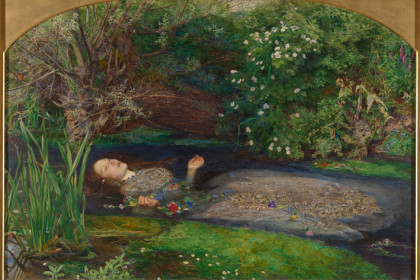
A simple exhibition? No, this is THE exhibition: the one to see “absolutely”. Pre-Raphaelites. The utopia of beauty, in Turin until July 13th, 2014, presents seventy works of the Pre-Raphaelite Brotherhood from Tate Gallery in London: arrived in Italy as the last stop of a world tour, they will then be placed in a wing dedicated to them in the English museum. The opportunity is rare, considering that the works will remain at the Tate for several years.
The story of the Brotherhood begins with three young rebel artists – John Everett Millais, Dante Gabriel Rossetti and William Holman Hunt – who wanted to challenge the suffocating atmosphere of the Victorian era creating works inspired truer and directly to nature, history, religion, literature. Founded in September of 1848, the movement wanted to change society through art inspired by the ideals of the past and of the very early Renaissance. They painted landscapes en plein air to faithfully reproduce every flower, every blade of grass; the woman, important focus of their representations, was a real person and artists often portrayed their companions or those of the members (with the finest of the gossip about it) – with a sensuality even ostentatious. Their pictures tell stories, often taken from Dante or Shakespeare, the Arthurian cycle or the Bible.
As in the Anglo-Saxon tradition of teaching, the exhibition is organized into well delineated and very enjoyable sections; the themes identified are History, Religion, Landscape, Modern Life, Poetry, Beauty, Symbolism, within which are placed works by internationally renowned and lesser-known works. The impact is strong from the first room, where dominates Ophelia by John Everett Millais – “loveliest English Landscape, haunted by sorrow” in the words of Ruskin – almost manifesto of the exaggerated naturalism sought by the Pre-Raphaelites, with its cold and shiny light and the exasperated attention to detail that gives the scene a sense of unreality accented by brilliant color range. On the wall beside there is the romantic and highly symbolic Chatterton by Henry Wallis: the suicidal poet is a martyr of the company, posing as a dead Christ, the marble pallor contrasts with the bright red hair and blue pants; from the window it glimpses the leaden sky and the twilight of already industrial London, the only hope seems to be entrusted to the flower on the windowsill.
Many of the works are by Dante Gabriel Rossetti, both oils and watercolors (there are also two works of his girlfriend, Elizabeth Siddal, the model of Ophelia); he closes the exhibition with some female busts, works in which emulates the Venetian art of the sixteenth century but where modern chromaticism favors the narrative. Three superb women greet the visitor output: The beloved, Monna Vanna, the blue and powerful Proserpina of vibrant soul.
It is not always necessary to know the lives of the artists to love their art: in this case, however, the personal stories are compelling as a novel, it is worthwhile to pursue them (maybe in this way). And never as in this case, photographs do not do justice to originals. Pre-Raphaelites. The utopia of beauty is a feast for the eyes and nourishment for the soul.
 English
English  Italiano
Italiano 


